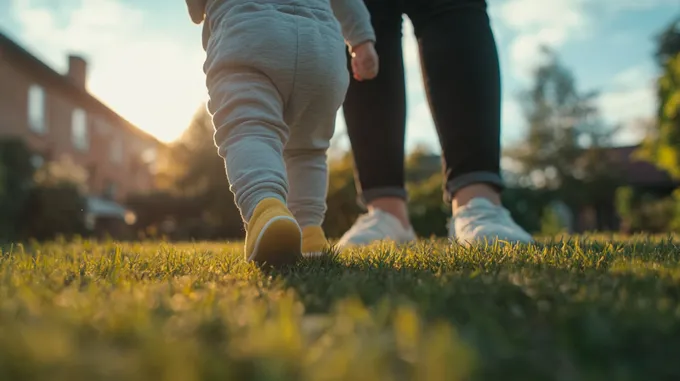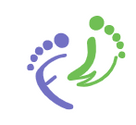Gait Abnormalities in Children: Types, Causes and Treatment
Updated June 10, 2025

After initially learning how to crawl and pull themselves up using your furniture, your baby started walking.
You're ecstatic and couldn't be prouder that they've reached this first milestone. However, imagine how quickly your smile turns upside down when you're spending time with your little one and notice your baby walking funny.
To help with your research and Googling, here is a complete guide to gait abnormalities in children.
What is an Abnormal Walking Gait in Children?
First things first, let's address what exactly is an abnormal gait in children.
A gait abnormality is an unusual way of walking. It's pretty common for young children to have an abnormal gait for a while as they grow and get used to moving around.
It's important to remember that most kids will experience an odd gait but grow out of it without medical treatment.
What is a Normal Walking Gait in Children?
Before diving into what's considered an irregular gait, we must understand what a "normal" walking pattern is.
Babies typically begin to walk when they're about one year old. At first, it's normal for your little one to walk with a wide-based, externally-rotated gait.
They may also take lots of short steps. Why? Well, this is because it takes several years for babies to develop balance and leg strength.
Development Milestones in Children
Let's take a look at some typical development milestones in children:
- 6 to 8 months: sit without support and rollover
- 9 to 12 months: crawl, cruise, bottom shuffle, or pull up using furniture
- 12 to 14 months: walk independently
- 15 to 16 months: climb upstairs and run stiffly
- 20 to 24 months: walk down steps
- 3 years: walk up steps
- 4 to 5 years: hop on one foot, jump, and skip
- 6 to 7 years: balance on one foot for 20 seconds
Keep in mind that kids' physical development can vary. Some may reach these milestones sooner, and some may reach them later.
It doesn't necessarily mean that something's awry just because your little one seems to be progressing slower than other children their age.
A mature gait pattern is typically established by the age of three. Then it should resemble that of an adult by around seven years old.
Normal Walking Gait in Adults
What does the normal adult gait cycle look like? Well, it goes a little something like this:
- Heel strike
- Stance
- Toe-off
The stance phase is when the foot makes contact with the ground, and the swing phase is when the foot leaves the ground.
Types of Gait Abnormalities in Children
The most common gait abnormalities types in children are the most common types of gait abnormalities in adults.
Some gait deviations in children are considered normal for the first several years as they figure out the whole walking thing.
In-toeing Gait in Children
From the age of 3 to 8, your child may experience in-toeing - walking with the knees and feet pointing inward.
Out-toeing
Out-toeing is where a baby walks with feet turned out from birth to 18 months maximum.
Both the in-toe and out-toe ways of gait walking aren't unusual until your little one has surpassed the age of 7. Although they may sound painful, they're typically not.
Antalgic Gait
An antalgic gait is where your child seems unwilling to weight-bear on a particular side. This could be because of trauma to the sole of one foot or a spinal infection.
Circumduction Gait
Circumduction gait is also known as "peg leg." This is where there is excessive hip abduction, which is the movement of the leg away from the midline of the body, as the leg swings forwards.
Spastic Gait
Spastic gait looks like a baby dragging a foot when walking. Their legs will be stiff, with the foot twisting inwards. This can be seen in upper motor neuron neurological disease.
Ataxic Gait
Ataxic gait is where your child is experiencing gait instability when they walk. They may have a narrow to a wide base of the gait.
Trendelenberg's Gait
Trendelenberg's gait can result from hip abductor muscle weakness. Your little one may weight-bear on one side, which causes a waddling gait with hips, knees, and feet externally rotated.
Stepping Gait
Stepping gait is where your child has to lift their entire leg at the hip to help them clear the ground. It can be observed in motor neurone neurological disease.
Clumsy Gait
Clumsy gait is a term that's used to describe gait difficulties in motor coordination, such as frequent falls or struggling to dress or feed. Your little one may also have poor handwriting or learning disabilities.
Causes of Abnormal Gait in Children
Different types of gait patterns in children have various causes.
Tibial Torsion
Tibial torsion can either be internal (baby knees point forwards but feet turn inward) or external (baby learning to walk with feet turned out). The good news is that the condition often improves without treatment before a child turns 4.
Some children may be asked to wear a night brace between 18 to 30 months old in rare cases. Likewise, doctors would only consider surgery if the child is 8 to 10 years old and is really struggling to walk.
Toe Walking
Also referred to as "equinus," toe walking is one of the most common gait abnormalities in child development. It essentially means heel contact is absent and can happen until your little one is almost 3.
Toe walking usually resolves on its own over time. Most cases run in families or are caused by tight muscles.
Occasionally, toe walking may indicate a neuromuscular disorder, dysplasia of the hip, or a leg length discrepancy.
Watch out for if your little one walks normally to start with and then walks on their toes or has the tightness of their Achilles' tendons. They may need treatment, such as physical therapy, bracing, casting, or even surgery.
Femoral Version
Femoral vision is when your child's upper leg turns inward or outward, causing the feet to twist inward or outward.
This condition may first become noticeable between the ages of 2 and 4, when the hip's inward rotation increases.
Usually, it will get better with time and won't require medical intervention. Doctors only consider surgery if the child is older than nine or has a very severe case.
Metatarsus Adductus
"Metatarsus adductus" is a common positional deformity relating to the C-shaped border of the foot. It makes a kid's feet bend inward from the middle of the foot to the toes.
Although the condition can resolve on its own by the age of 6, it may need treatment. The treatment may consist of special exercises, corrective shoes, or casts.
Bowlegs and Knock Knees
Bowlegs is not unusual with out-toeing where a baby walks with feet turned out from birth until they're 18 months old. It involves the legs curving outwards at the knees.
Knock knees, on the other hand, is associated with inward feet until the age of 7. It's what happens when the legs curve inward at the knees.
Both bowlegs and knock knees typically self-correct as a child grows.
Flat Feet
Flat feet are widespread in infants and young children.
Most kids have a flexible foot with a normal arch when they tiptoe. However, children with flat feet have arches that aren't yet developed, so their entire feet press against the floor.
The arches typically develop throughout childhood until the age of 10.
Limping
Limp gait is most likely caused by a minor injury, such as splinters, tired muscles, or blisters.
In rarer cases, limping can signify a more serious problem like a sprain, dislocation, fracture, joint infection, or autoimmune arthritis.
Chronic limping may indicate a developmental problem, such as leg length discrepancy or hip dysplasia if it's not painful. It could also indicate a neuromuscular problem like cerebral palsy.
Treatment for Abnormal Gait in Children
If your child cannot walk well and independently by 18 months, they could be experiencing one of the different types of gait abnormalities. In this case, it may be a good idea to visit your paediatrician and get them checked out.
Your child's doctor will conduct a physical exam of their legs and feet. They will also assess how they walk or run.
Some of the things they may ask are:
- How long has your child struggled to walk properly?
- Does your child show any signs of being in pain when they walk?
- Have any of your close family members had long-term walking disorders?
Other diagnostic procedures could include:
- X-rays, which can be used to review bone structure and alignment
- A Computerised Tomography scan (also known as a CAT or CT scan) shows detailed images of the bones and joints
- Magnetic Resonance Imaging (MRI), where you can see soft tissues and structures within the body to rule out any related abnormalities of the spinal cord and nerves
How are paediatric gait abnormalities in kids treated? Well, A doctor will monitor your child over several years to see how their legs and walking patterns develop.
Fortunately, the majority of abnormal gait patterns in children will resolve without any intervention as they grow.
However, if an unusual walking gait is caused by an injury or development condition, your child's doctor will treat that specific condition.
The Takeaway
Many common conditions can cause your little one to walk with their feet turned inward or outward or with some other kind of abnormal gait.
Even so, rest assured, all types of walking abnormalities typically improve on their own during childhood.






